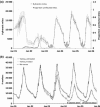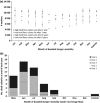BEEHAVE: a systems model of honeybee colony dynamics and foraging to explore multifactorial causes of colony failure
- PMID: 25598549
- PMCID: PMC4283046
- DOI: 10.1111/1365-2664.12222
BEEHAVE: a systems model of honeybee colony dynamics and foraging to explore multifactorial causes of colony failure
Abstract
A notable increase in failure of managed European honeybee Apis mellifera L. colonies has been reported in various regions in recent years. Although the underlying causes remain unclear, it is likely that a combination of stressors act together, particularly varroa mites and other pathogens, forage availability and potentially pesticides. It is experimentally challenging to address causality at the colony scale when multiple factors interact. In silico experiments offer a fast and cost-effective way to begin to address these challenges and inform experiments. However, none of the published bee models combine colony dynamics with foraging patterns and varroa dynamics.We have developed a honeybee model, BEEHAVE, which integrates colony dynamics, population dynamics of the varroa mite, epidemiology of varroa-transmitted viruses and allows foragers in an agent-based foraging model to collect food from a representation of a spatially explicit landscape.We describe the model, which is freely available online (www.beehave-model.net). Extensive sensitivity analyses and tests illustrate the model's robustness and realism. Simulation experiments with various combinations of stressors demonstrate, in simplified landscape settings, the model's potential: predicting colony dynamics and potential losses with and without varroa mites under different foraging conditions and under pesticide application. We also show how mitigation measures can be tested.Synthesis and applications. BEEHAVE offers a valuable tool for researchers to design and focus field experiments, for regulators to explore the relative importance of stressors to devise management and policy advice and for beekeepers to understand and predict varroa dynamics and effects of management interventions. We expect that scientists and stakeholders will find a variety of applications for BEEHAVE, stimulating further model development and the possible inclusion of other stressors of potential importance to honeybee colony dynamics.
Keywords: Apis mellifera; Varroa destructor; colony decline; cross-level interactions; feedbacks; foraging; modelling; multi-agent simulation; multiple stressors; predictive systems ecology.
Figures






References
-
- Boot, W.J. , Schoenmaker, J. , Calis, J.N.M. & Beetsma, J. (1995) Invasion of Varroa jacobsoni into drone brood cells of the honey bee, Apis mellifera . Apidologie, 26, 109–118.
-
- Bühlmann, G. (1985) Assessing population dynamics in a honeybee colony. Mitteilungen der Deutschen Gesellschaft fuer Allgemeine und Angewandte Entomologie, 4, 312–316.
Grants and funding
LinkOut - more resources
Full Text Sources
Other Literature Sources
